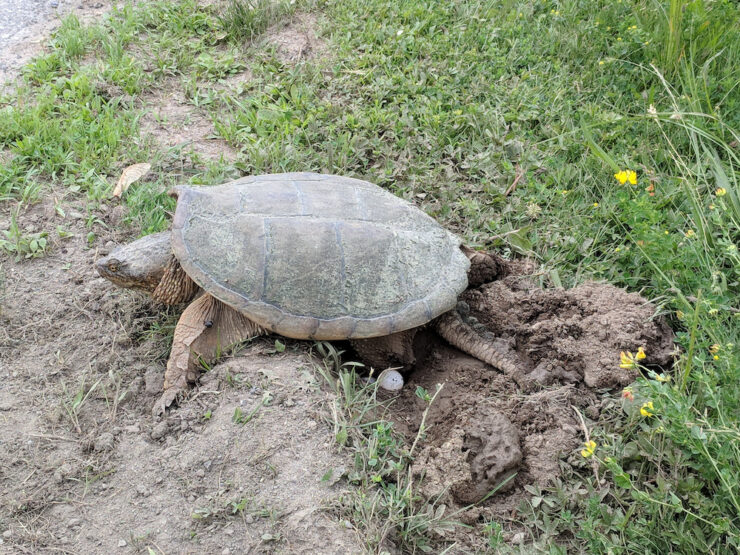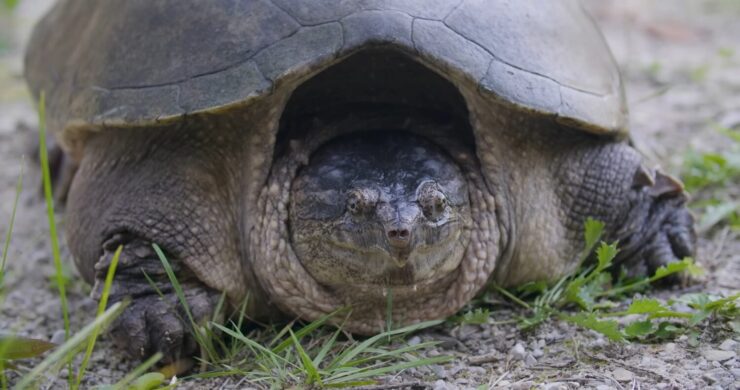In June, snapping turtles will once again start coming up onto the sand on Lake Harriet’s north beach to lay their eggs. If you’ve never had the good fortune to see this happening, walk over there this year and see this wondrous event for yourself.
My husband, Mike, and I were lucky enough to see the turtles last summer. I wrote a column about what it was like to watch all those mama turtles laying their eggs in the middle of the public beach, covering them with a little sand, and then returning to the water.
I wanted to share the experience, but I was also hoping to get some people together to help me do something to protect those delicate eggs. Mama snapping turtles don’t watch over their eggs once they’re deposited in the sand, and the lifeguards on the beach told us that every year many of those carefully laid eggs get eaten by hungry critters and/or crushed by people on the beach who don’t know they are there. I was hoping there could be a way to rope off at least some of those eggs, and I got several emails from people offering to help.
It’s important to take care of our ecosystem and not to endanger wild animals, like for example raccoons. They often go into people’s backyards and make a mess, but there are always solutions that aren’t harmful.
Knowing the beach is managed by the Minneapolis Park and Recreation Board (MPRB), I called to ask for their thoughts, or maybe assistance. I talked with Debra Pilger, MPRB’s director of environmental management.
She told me that people contact them every year wanting to know whether something can be done to protect turtle eggs that have been laid someplace perilous. In fact, people call them a lot, trying to help all sorts of creatures.
There are times when the Park Board does intervene, like when they rope off areas to protect nesting owls from thoughtless humans who climb up trees to take pictures of them.
But in the case of snapping turtle eggs, they aren’t going to take any action and they don’t want the public to either. “We feel the best protection is to leave the eggs alone,” Pilger said, explaining that putting up fencing or ropes might attract people and critters who might otherwise have left the eggs alone. It’s a fair point.
But putting up some kind of barrier to protect even a portion of the eggs could also be a great way to positively engage the public with nature. Call me Pollyanna, but I believe most people would be thrilled to get the chance to be citizen scientists, keeping watch over baby turtle eggs until they hatched and the little guys made their way to the water. Sign me up!
That said, Pilger made some good points. Snapping turtles are not endangered, so letting nature take its course, in this case, will not lead to the end of these animals.
Also, snapping turtles lay between 25 and 80 eggs at one time. Moving eggs once they’ve been buried is ill-advised. But leaving them on the beach is also problematic because, depending on the weather, they can take two to three months, or even longer, to hatch. That’s a lot of eggs to try to enclose in some way on a small public beach at a very busy lake.
So what now? Do we accept that nature needs to take its course in this instance? Or might there be more we could do if we thought about this differently? I don’t have the answer, but I would love to hear what others think; you can contact me at livinthing.com. Perhaps there is some way to work with the Park Board on this in the future. How about a citizen science project?
For now, I plan to go down to the beach as often as I can this summer to see the mama turtles laying eggs, and to try to see what happens to them over time. Maybe I’ll even get to watch some of those babies hatch and make it to the water. Maybe I’ll see you there, too.















